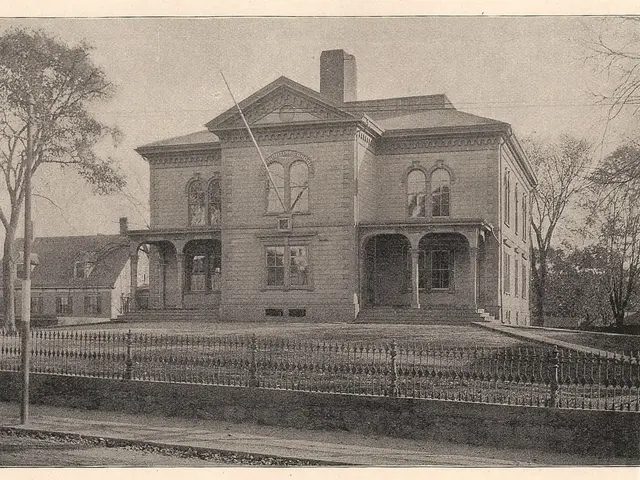Getting to the Heart of Policy Impact: Unraveling Public Opinion's Role
Role of Public Opinion in Policy Formulation: Detailed Examination
Public opinion, as the collective assessment of citizens, shapes the policy landscape in mature democracies. Explore the intricacies of how this gauge impacts four key types of policy outputs: distributive, redistributive, regulatory, and constituent policies. This piece dissects the conditions under which public opinion sparkles the brightest, and the instances where its influence dims.
The Opinion Tapestry in Policy-Making
Public opinion, a assortment of individual attitudes or beliefs from the general public, serves as a compass for policy-makers. It reflects the populace's needs, preferences, and priorities, setting the stage for political chatter and often tailoring policy directions.
Policy by the Numbers: Four Varieties
- Distributive Policies: These policies deliver resources or services from the government to particular groups, such as grants or subsidies. Public opinion is usually an essential factor when shaping these policies, as voters' needs and preferences are articulated in their demands.
- Redistributive Policies: With the goal of redistributing resources among different social classes, they encompass tax structures and welfare programs. Public sentiment significantly influences their construction and execution, with voters' support or opposition playing a significant role in their inception and implementation.
- Regulatory Policies: These govern restrictions and establish regulations upon certain activities. Public opinion weighs heavily during the formation of these policies, especially in areas concerning health, safety, and environmental protection, where public involvement and activism proliferate.
- Constituent Policies: These determine government structures and processes. Public opinion displays less influence on such policies, as they involve complex institutional changes that often escape the public's spotlight.
The Spotlight and Public Influence
Public opinion shines the brightest when issues are illuminated by visibility and emotional resonance. This public scrutiny tends to result in heightened civic engagement and pressure on politicians to respond. For example, in the aftermath of environmental tragedies or public health crises, public opinion significantly impacts the formation of regulatory policies. Similarly, in distributive and redistributive policies, when topics like unemployment or social welfare are the subjects of intense debate, public opinion occupies a powerful role in advocating for policy changes.
The Quiet Zone: When Opinion Wavers
Conversely, public opinion wanes its influence in scenarios that are innately complex, technical, or lack immediate significance for citizens. For instance, constituent policies, which involve intricate governmental structures and procedures, rarely see substantial direct impact from public opinion. Additionally, when public discourse is clouded by a lack of consensus or understanding, such as in certain foreign policy decisions or complex economic policies, public opinion's sway diminishes.
The Power Players Enhancing Public Influence
Several elements can amplify the effect of public opinion on policy outputs. These forces include:
- Media: Extensive media coverage of issues magnifies public concern and can steer policy discussions.
- Interest Groups: Organizations representing specific viewpoints can galvanize public opinion and advocate for policy transformations.
- Awareness Campaigns: Educational efforts can raise awareness about issues, increasing pressure on policymakers.
- Political Champions: Charismatic and powerful leaders can sway public opinion and channel it towards policy changes.
The Limits of Public Opinion's Reach
Though substantial, public opinion's sway is not unbounded. Factors such as misinformation, misconceptions, or apathy can dilute its effectiveness. Additionally, the might of powerful interest groups and political elites may sometimes cast a shadow upon public sentiment.
Witnessing Public Opinion in Action: Real-World Impact
To delve deeper into the influence of public opinion, consider the following case studies:
- Environmental Regulations: Overwhelming public concern about climate change has led to an uptick in environmental regulations. This transformation illustrates the potent impact public opinion can have on regulatory policies, especially when fortified by events like natural disasters or global summits.
- Healthcare Reform: Debates about healthcare in various countries demonstrate the power of public opinion. Policies addressing universal health coverage or insurance reforms most often derive from the public's rallying cry for more accessible and affordable medical services.
- Social Welfare Programs: Expansions or cuts to social welfare programs are usually correlated with public sentiment. In some scenarios, these redistributive policies are highly sensitive to shifts in public demographics and socio-economic circumstances.
The Voice of the Voters: The Indispensable Barometer
Polling and public surveys are indispensable tools in assessing public opinion. They inform policymakers about the preferences and priorities of their constituents and provide insights into the prevailing political climate. However, the precision and interpretation of these surveys can impact their influence on political decisions, with misleading polls often leading to policies that run counter to the public's will.
The Digital Frontier and the New Age of Public Opinion
The digital age has redrawn the landscape of public opinion formation. Through social media, diverse voices can share information and opinions in real-time, potentially shaping political discussions in real-time. Though the democratization of opinion can lead to more responsive policymaking, it also presents challenges associated with misinformation and polarization.
The Invisible Hand of Elites: Molders of Public Opinion
Though electors hold much sway, it is essential to recognize the role of political, economic, and media elites in crafting public opinion. These elites can influence public opinion through messaging and framing of issues. The delicate interplay between elite influence and grassroots opinions is a complex component of contemporary policy-making.
Predicting the Future: Trends in Public Opinion and Policy-Making
With the evolving patterns of technology, media, and societal values, the impact of public opinion on policy-making is prone to adaptation. The emergence of data analytics and artificial intelligence could provide a deeper understanding of societal sentiments, potentially leading to more targeted and effectual policy outputs.
The Classroom Calling: A Lifelong Lesson
For students of government and political science, understanding the intricacies of public opinion and policy-making is paramount. It not only equips them with an understanding of the practicalities of governance, but it also underscores the significance of knowledgeable and active citizenship in shaping policy outcomes.
Public opinion, which serves as a compass for policy-makers in policy-making, can significantly influence the formation of regulatory, distributive, and redistributive policies, especially when issues are illuminated by visibility and emotional resonance. Conversely, public opinion tends to wane its influence in scenarios that are innately complex, technical, or lack immediate significance for citizens, such as constituent policies. Media, interest groups, awareness campaigns, and political champions can amplify the effect of public opinion on policy outputs, while misinformation, misconceptions, or apathy can dilute its effectiveness. Understanding the intricacies of public opinion and policy-making is essential for students of government and political science, as it equips them with an understanding of the practicalities of governance and the significance of knowledgeable and active citizenship in shaping policy outcomes.








